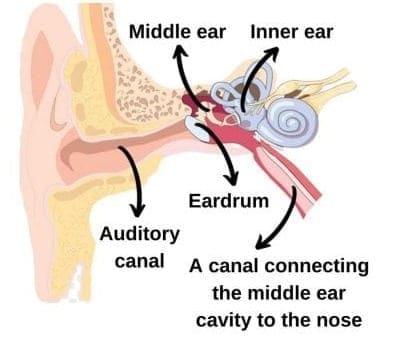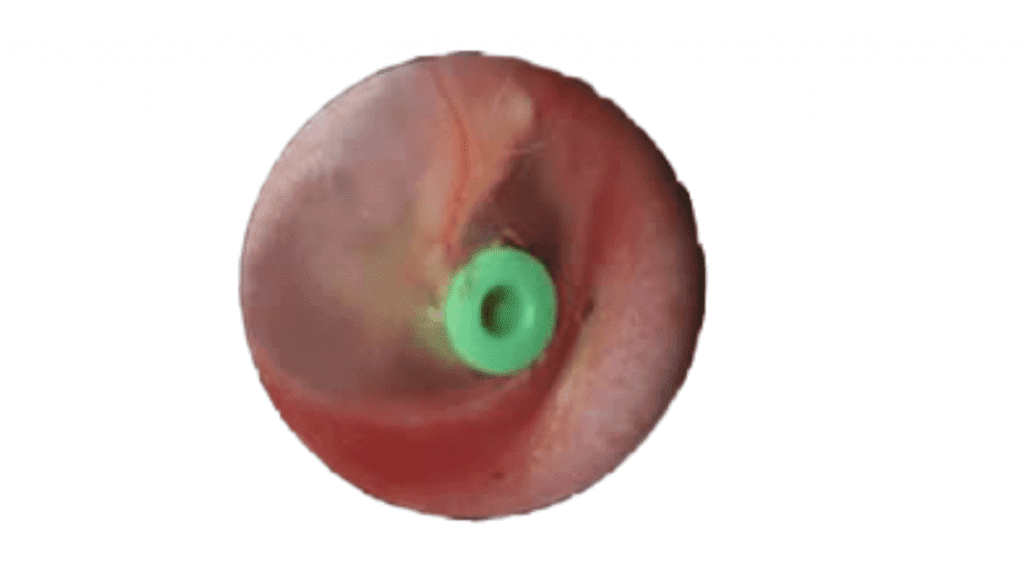
Otitis media with effusion (ear fluids)
Ear fluid, or in other words, and more correctly so, otitis media with effusion, is a very common condition in pediatrics. And it is very confusing for parents.
Therefore, I am sure that a parent who understand the main differences between acute otitis media (see here) and otitis media with effusion (ear fluid) can help their child receive better care from their pediatrician.
I wrote the following chapter with the help of Dr Roy Hod, a fantastic specialist in otorhinolaryngology, and he is also on the list of recommended physicians on Dr Efi’s website.
What is otitis media with effusion (ear fluid) and how do fluids reach the ear?
Take a look at the image of the structure of the ear, which is composed of three parts, the external ear, the middle ear and the inner ear.
The middle ear is, in fact, a cavity that starts at the eardrum and ends at an additional small membrane called the oval window, which is where the inner ear starts. From that same middle cavity emerges another cavity, with a second opening in the space behind the nose.
When people hear of the term ear fluid for the first time, they imagine a pool of water entering through the nose or through the ear canal. But the real process is an inflammatory one, where there is an accumulation of secretory fluids in the middle ear, made up of mucous and inflammatory cells. In children, there are several risk factors and different triggers that can cause the accumulation of these fluids, including genetics, passive smoking and recurrent viral infections.
But the most important factor is the anatomical structure – if the cavity that connects the middle ear to the nose is obstructed (for example in recurrent viral infections, third tonsil, etc.) or does not function well anatomically (it is short, narrow or has too much of a horizontal angle), the ventilation of the inner ear is affected and inflammatory fluids accumulate inside.
What is the association between third tonsil and ear fluid?
The third tonsil (or adenoid or polyp, as referred to by some people) is a tissue that is found at the back of the nose in children. The third tonsil is located very close to that same cavity that connects the middle ear to the nose. If the third tonsil is large and obstructs the drainage or ventilation of that cavity, it could cause otitis media with effusion. Therefore, as you will learn below, we often offer combination treatment (ventilation tubes and removal of the third tonsil). If you would like to learn more about the third tonsil in children, follow this link.
What is the association between otitis media with effusion (fluid) and acute otitis media?
On the one hand, these are two separate processes that occur in the same place. On the other hand, they could be considered a spectrum of the same disease process, where the beginning of one is the end of the other. Complicated.
Ear fluid – a chronic inflammatory process (not infectious). Seemingly, if we sample this fluid it will be sterile (this is not completely accurate, but easier to think of it this way for simplification purposes). Therefore, treatment with antibiotics, for example, will not be useful.
Acute otitis media – an acute infectious process caused by a pathogen (usually bacteria). Therefore, antibiotics here will be of use.
In practice, the association between these two is a bit more complicated because some believe that they are a spectrum of the same disease. The beginning of acute otitis media is often the end of otitis media with effusion.
Let’s conclude that the association is as follows: ear fluid provides a comfortable platform for bacteria to thrive, even though in most cases it does not cause any harm and does not lead to acute otitis media.
How can we distinguish between otitis media with effusion (fluid) and acute otitis media?
Sometimes it is difficult to distinguish between the two and we need the help of a skilled eye. In both cases, when observing the eardrum, you can identify fluid behind the eardrum and possibly a slight bulging. But the presence of ear fluid is a chronic condition, that does not cause pain, while acute otitis media is usually painful and accompanied by fever, and local findings on the eardrum such as redness, bulging and turbidity.
Is otitis media with effusion (ear fluid) contagious?
Fluid in the ear is not contagious and should therefore have no impact on a child’s daily activities, including school and daycare.
Can ear fluid cause hearing loss? Which children need to be investigated for hearing loss?
Most of the time, ear fluid can cause a slight conductive hearing loss, but it does not last for too long. This hearing loss in children is insignificant. Nonetheless, there are cases where ear fluid can cause hearing loss up to 50 decibels, which is considered moderate hearing loss. If the loss is unilateral, then the person will not feel it. However, if it is bilateral, is up to a considerable degree and prolonged, then it can significantly affect hearing and affect the child’s speech abilities.
Keep in mind that in children with other developmental problems (speech, behavioural or developmental), even a slight reduction in hearing can influence their primary condition, and these children are to be monitored and provided with adequate consults.
Therefore, in children who seem to have hearing loss that affects their daily life, or in children with ear fluid for a period of over three months, it is important to perform a proper hearing test. A good hearing test, performed by skilled hands is one that is done at an auditory center that is used to examining children and one that is successful at distinguishing between the auditory capabilities of each ear separately, including the degree of hearing loss with and without ear fluid.
Some people like to associate hearing loss, with or without ear fluid, with all their troubles in the world. For example, a child with behavioural issues or attention deficit. Hypothetically speaking, and according to the medical textbooks, ear fluid, especially if prolonged, can cause these problems, as it can cause posture disorders, etc. But we must keep in mind that in most cases, ear fluid is a condition that can come and go over a period of months, and mostly does not cause any problems at all in children.
What are the available treatments for ear fluid in children?
Again, I’m here to remind you that most of the millions of children who have ear fluid do not need any monitoring or treatment. Further investigation and treatment are to be performed only in those who have evidence of ear fluid for a period of over 3 months, in cases of hearing loss that causes further disorders or if there is recurrent otitis media.
Nowadays, the available therapies include:
# Different types of nasal sprays that mostly contain salt water – they can provide some relief but are more commonly used in adults.
# Antibiotics – not at all. Antibiotics should not be used to treat otitis media with effusion.
# Anti-histaminic medications (anti-allergic) – in most cases these types of medication are not useful because this condition is not an allergy.
# Steroids (used systemically or as a nasal spray) – in the short term, steroids can provide relief but in the long term they do not have an effect on this medical condition. The use of steroids is not common practice in children.
# Anti-congestion medication – these are not used in children, especially not in children under the age of two. In addition, there is no evidence that they are useful.
# Nasal drops such as dethamycin – are not useful in the long run.
# Blowing up balloons, salt rooms and all kinds of other made-up stuff – do not work.
The hardest thing for a doctor is to stand in front of parents and tell them that there are no available therapies that actually make a difference to their child’s condition in the long run.
The only therapy that solves the issue of ear fluid is surgery for insertion of ventilation tubes.
What are the different considerations before surgery for insertion of ventilation tubes?
Prior to surgery, there are several important points that need to be taken into consideration:
1. Most children who have ear fluid do not need monitoring or treatment. The fluid does not have any short term or long-term effects, and therefore does not require intervention. Most ear fluid resolves within weeks or months.
2. In many countries in the world, surgery for insertion of ventilation tubes is the most common ambulatory surgery performed, and sometimes it feels like it is more of a business. Therefore, I suggest you consult with your pediatrician with regards to the real need for it, as well as with a recommended pediatric ENT specialist, and do not rush to perform surgery without a clear indication. When consulting with the surgeon, make sure you take into consideration the different factors that may affect the need for surgery, including: the age of the child, the season (there is a difference between consulting with a surgeon before the winter season or consulting before summer season, when the rates of viral infections usually drop), the number and severity of ear infections the child experiences and the length of time since the last infection, the presence of fluid in one or both ears, the length of time the fluids have been present and most importantly, the degree of hearing loss and resulting developmental disorders.

What is surgery for ventilation tube insertion and how is it associated with the third tonsil?
Surgery for ventilation tube insertion includes a surgery when a ventilation tube is inserted through a small incision that is made in the eardrum (one on each ear). Following the insertion of the tubes, the middle ear cavity becomes open to the auditory canal, allowing ventilation of that cavity, drainage of the fluid, improvement of the hearing loss and usually also a reduction in the rates of middle ear infections.
There are two types of ventilation tubes. One type is used for short term (usually fall out six months to one year from insertion), and another is for long term. Most of the time, the short term tubes are used in children.
In many of the cases, a surgical removal of the third tonsil that caused nasal obstruction is performed at the same time. But I will leave the details about this for another chapter, found in the link here.
In summary, ear fluid is one of the most common topics in pediatrics. If you read and understand what I have written here, I promise you you will be able to make better decisions for your child.
Good luck!
For comments and questions, please register
